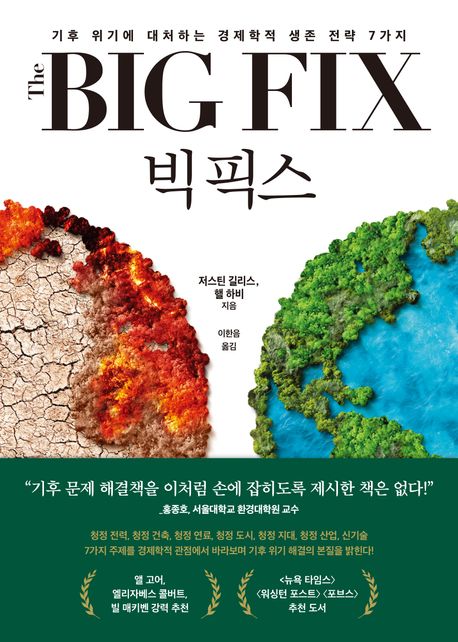
단행본
Climate Economics: Economic Analysis of Climate, Climate Change and Climate Policy
- 판사항
- Third edition
- 발행사항
- Cheltenham : Edward Elgar Publishing Ltd, 2023
- 형태사항
- xxii, 263p. ; 25cm
- 서지주기
- Includes bibliographical references and index
소장정보
| 위치 | 등록번호 | 청구기호 / 출력 | 상태 | 반납예정일 |
|---|---|---|---|---|
이용 가능 (1) | ||||
| 자료실 | E208333 | 대출가능 | - | |
이용 가능 (1)
- 등록번호
- E208333
- 상태/반납예정일
- 대출가능
- -
- 위치/청구기호(출력)
- 자료실
책 소개
This thoroughly revised third edition offers comprehensive coverage of the economics of climate change and climate policy, and is a suitable guide for advanced undergraduate, postgraduate, and doctoral students. Topics discussed include the costs and benefits of adaptation and mitigation, discounting, uncertainty, equity, policy instruments, the second best, and international agreements.
Key features:
In-depth treatment of the economics of climate change
Careful explanation of concepts and their application to climate policy
Customizable integrated assessment model that illustrates all issues discussed
Specific usage guidelines for each level of reader
Companion website with data, quizzes, videos, and further reading
Discussion of the latest developments in theory and policy
Greater attention to policy and market imperfections than in the second edition.
This book is an essential text for students in economics, climate change, and environmental policy, an excellent resource for researchers and practitioners, and a key text to support professors in their teaching.
목차
Preface
Introduction
1. The science of climate change
Tweet book
Processes
Projections
Further reading
2. Emissions scenarios and options for emission reduction
Tweet book Sources of greenhouse gas emissions
Trends in carbon dioxide emissions
Scenarios of future emissions
Options for emission reduction
Further reading
Exercises
3. Abatement costs
Tweet book
The costs of emission reduction
Negative abatement costs
Further reading
Exercises.
4. Policy instruments for emission reduction
Tweet book
The justification of public policy
Direct regulation
Market-based instruments
Cost-effectiveness
Dynamic efficiency
Environmental effectiveness
Taxes versus tradable permits under uncertainty
Initial allocation of permits
Initial and final allocation of permits
International trade in emission permits
Technological change
Emissions trade in practice: The EU Emissions Trading System
Emissions trade in practice: The Clean Development Mechanism
Further reading
Exercises
5. Impacts and valuation
Tweet book
Impacts of climate change
Purpose of valuation
Valuation methods: Revealed preferences
Valuation methods: Stated preferences
Issues for climate change: Benefit transfer
Issues for climate change: WTP versus WTAC
Further reading
Exercises.
6. Impacts of climate change
Tweet book
Reasons for concern
Total economic impacts
Impacts and development
Marginal economic impacts
The growth rate of the marginal impact
Further reading
Exercises
7. Climade and development
Tweet book
Growth models
Natural disasters
Poverty traps
Further reading
Exercises
8. Optimal climate policy
Tweet book
The ultimate target
Benefit-cost analysis
Estimates of optimal emission reduction
Trade-offs between greenhouse gases
Further reading
Exercises.
9. Discounting, equity, uncertainty
Tweet book
Time discounting: Derivation of the Ramsey rule
Time discounting
Declining discount rates
Axiomatic approaches to intertemporal welfare
Equity
Derivation of equity weights
Uncertainty
Ambiguity
Deep uncertainty
Implications for climate policy
The choice of parameters
Science and advocacy
Further reading
Exercises
10. Irreversibility and learning
Tweet book
Introduction
A stylized example
Applications to climate change
Further reading
Exercises.
11. International environmental agreements
Tweet book
Cooperative and non-cooperative abatement
Free-riding
Cartel formation
Multiple coalitions
International climate policy
Further reading
Exercises
12. Adaptation policy
Tweet book
Adaptation versus mitigation
The governement's role in adaptation
Adaptation and development
How to adapt
Further reading
Exercises.
13. Building an integrated assessment model
Introduction
Carbon cycle and climate
Scenarios
Abatement
Tradable permits
Impacts of climate change
Social cost of carbon
Development
Optimal climate policy
Discounting and equity
Uncertainty
Non-cooperative climate policy
Adaptation policy
14. How to solve the climate problem?
Tweet book
The problem
Costs and benefits of climate policy
Complications
The solution
Further reading
Index.


